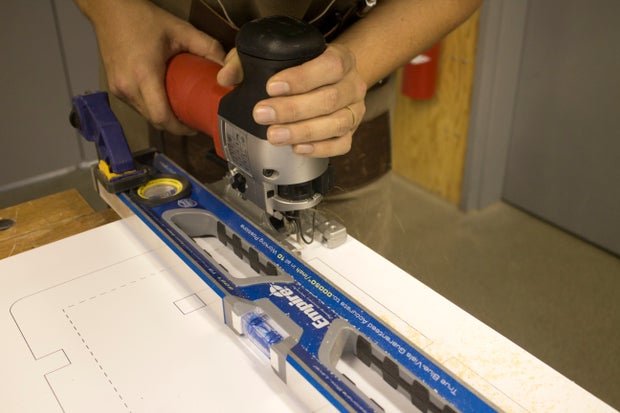Introduction: Off Grid Power Supply
This project is quiet, indoor friendly alternative to a gas powered generator. If you're charging devices, using lamps, or even running an electric motor for a limited time, this off grid power supply is a great companion for camping or emergency situations.
Step 1: Tools + Materials
This is a great CNC machine for furniture-sized projects. It's got a 33"(X) x 33"(Y) x 3"(Z) cutting area and it's fully compatible with Fusion's CAM tools. The post processing in Fusion seems to work very well with all the tests I've tried.

Or Be Your Own CNC...
If you don't have a CNC router, all you need is a hand drill, a jigsaw with a metal cutting blade, a large format print from a print shop, and some patience. Here's a link to my Digital Fabrication by Hand instructable, showing you how to be your own CNC machine: https://www.instructables.com/id/Digital-Fabrication-By-Hand/
I'll provide PDF drawings in the next step that you can use as templates to cut out your own parts by hand with a jigsaw.

3D Printing
I use a Prusa I3Mk3S for just about everything. It's the best bang for your buck, in my opinion- very well made, 3D printable replacement parts, accurate and reliable.
3D Print Filament
- I used Matte Fiber HTPLA from Proto-pasta for this project, but pretty much any filament will work. I like this stuff because the finish looks really good.
Electronics
- Power Inverter: ($61) 800 Watt Continuous / 1600 Watt Peak Power
- 12V Deep Cycle Battery: ($64) Be sure to use a deep cycle battery, a car battery will run out very quickly!
- 12V AC Battery Charger: ($54) This charges the battery from a wall outlet when it's available.
- AC Power Socket: ($7) This connects to the AC battery charger. Be sure to use one that has a fuse!
- Cigarette Lighter Terminal: ($6) This terminal connects to the battery and can be used for DC charging, such as with solar panels.
- 12V Battery Meter: ($15) This gives you voltage and percentage of battery power.
Total: $210 (not counting wood and 3D print filament)
Hardware
All of the following hardware can be substituted for smilier hardware available in your location and on your budget, but the CNC files are designed with these parts.
- 1 1/2" wood screws
- 1" Ø tubes for cross bars. I used some carbon fiber tubes that I found laying around in the shop, but any PVC tube or wooden dowel will do. These should be cut to 8 5/8" long.
Materials
- 32" X 32" 1/2" thick MDF sheet. Any 1/2" material will work with the files I'm providing.
- Glossy Epoxy resin for waterproofing
Software
Fusion 360 is free and it's awesome. I use it for everything I design and fabricate. If you have access to a CNC machine, it's about as good as it gets when it comes to easy and fast CNC programming.
Student / Educator License (renew free every 3 years)
Hobbyist / Startup (renew free yearly)
Step 2: Design + Fabrication
Just like everything else I make, I designed this project in Fusion 360. I love it because it's so easy to make CAM setups of the things you design, as you'll see in the Fusion archive that's attached here. If you take a look at the parameters list, you'll notice that I'm using a material thickness parameter. This is important because the interlocking parts (held together with screws through pilot holes) can be automatically updated if you're using a different material.
The STL files are for the end caps that hols the cross bars. The capMid piece is meant to be a connection piece for the side panels, but I ended up not using them because I glued the sides onto the box.
The DXF files are vector files that can be used for CNC or laser cutting.
The PDF files are printable files that can be used at templates for hand cutting. They should be printed at 100% on whatever sheet size they'll fit on.
Layout.PDF is for 1/2" material.
Face Plate.PDF is for 1/8" material.
Step 3: Parts Assembly
The battery and charger fit into slots on the insert piece and are held down with zip ties and screws with washers as seen in the photos. The inverter is fastened with screws through pilot holes in the side of the box.
The diagrams above show where the parts in the face plate belong. I used power pole connectors to connect all the electronic parts, but you could easily do it all with screw-on wire caps from any hardware store.
Step 4: Chassis Assembly
The assembly is basically just a box with X-shaped side pieces. These pieces protrude past the main box and make feet that have carbon fiber cross bars. These bars make good handles for moving the power supply, but the idea is that they also can be used to attach it to a roof rack or something like that.
I used 2" wood screws to attach the end caps to the X-shaped panels as shown in the diagram. The caps were a bit snug, I would probably make the tolerance bigger for those pieces if I were to do it again.
Step 5: Go Off the Grid!
I ran a shop vac off of this power supply for about an hour before the inverted started beeping (warning me that the output was going below 10V). We used it at a cabin in the woods for a weekend charging phones, bluetooth speakers, and fluorescent lamps, and in 48 hours we still had power.
I'd like to try charging it with solar panels to get a sense of how well it would work with that kind of system. Let me know what you think in the comments!




















